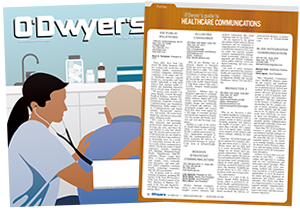
Tim Bird |
The role of advocates as communicators
|
|
The personal experiences of individuals who have been affected by an illness or disease can illustrate its impact in a way that nothing else can. Consider a parent whose child is struggling with an incurable and fatal genetic disorder, a teen facing lifelong consequences from a vaccine-preventable illness, or a family coping with the progression of a degenerative condition. Their voices are unique and incredibly powerful assets because, unlike statistics, they humanize the disease.
Each advocacy organization has needs and goals specific to the population it represents. These can vary from conducting grassroots or wide-reaching educational programs to driving national or state policy changes or highlighting unmet treatment needs. Patient advocates and organizations often play an important role in leading or participating in stakeholder collaborations related to achieving these goals. Building communities for patients and families to find support and make connections is also an important function for many patient-focused groups.
Equipping advocates, unifying messages
Good advocate stories are compelling, credible, engaging, and motivating. All advocates start with a powerful experience and a passion for their cause, but not all are natural storytellers. Additionally, although they are intimately familiar with the personal impact of a disease, the scope of their knowledge may be limited. It’s important to balance their personal experience with relevant and accurate data and statistics such as epidemiology, treatment options, behavioral or other barriers. Advocates must tell a story that is easy to understand, informed, and aligned with the broader narrative of the driving organization or campaign.
Working with patient advocates to achieve the above presents communicators with a distinct challenge. It’s important to understand and show sensitivity to what patients have been through while helping them hone their stories. Communicators can also help support individual advocates and organizations by identifying or developing the most appropriate tools, platforms and tactics for implementing communications programs that help achieve their goals.
Below are some examples that illustrate the power of well-structured communications programs in advancing patient advocacy objectives:
Raising voices to accelerate research: Parent Project Muscular Dystrophy is the largest most comprehensive parent-led organization focused on finding a cure for Duchenne muscular dystrophy, the most common fatal, incurable and untreatable genetic disorder diagnosed in childhood which primarily affects boys. Their program has brought together patients and their families and friends to raise their voices in Washington, demand optimal care for all young men who have Duchenne and educate the global community. The results are many including accelerating research for a treatment to end Duchenne.
Advocating prevention through creative story-sharing and networking: Cervivor is a cancer survivor led community that features cervical cancer survivors telling their stories and an online retreat that promotes healing, connecting and thriving. Over the years, Cervivor has organized a range of innovative and creative activities to encourage screening and HPV vaccinations. These include YouTube webisodes on Cervivor TV as a way to make a difference; “HPVs” or House Parties of Five to help women educate each other; and “Cervivor School,” which is a series of events for women to connect with other survivors and advocates while working together to change the future of women’s health.
Engaging stakeholders to raise funding: Beyond Batten Disease Foundation was formed in 2008 by parents in response to their daughter’s diagnosis of Batten disease, a rare, fatal, inherited disorder of the nervous system that usually begins in childhood. Its mission is to eradicate Batten disease. Today, through a cohesive, one voice strategy called the Be Project, the organization is connecting families, communities, researchers and supporters across the globe to drive funding for research into Batten Disease treatment. Through its efforts, a clinical trial for a new treatment is now in sight.
Building a community of support: More Than Motion is a Facebook Group sponsored by the pharmaceutical manufacturer UCB as a place for people with Parkinson’s disease and their loved ones to receive information, help educate others about Parkinson´s disease and make connections with people like themselves. The online community of more than 76,000 is also a place to learn, share, act, and most importantly, have their voices heard.
Creating a network of powerful advocates: For National Meningitis Association, patient advocacy for prevention is a part of every aspect of the organization’s DNA. NMA was founded fifteen years ago by a small group of parents whose children died or live with permanent disabilities from meningococcal disease, a vaccine-preventable infection. When NMA was founded, there was little public knowledge about meningococcal disease. Also, at that time, vaccination was not recommended, and an organized support structure for affected families did not exist. Since its start, NMA has grown into a national organization that comprises parents and disease survivors who carry out NMA’s mission of educating others about meningococcal disease and its prevention. NMA provides ongoing training, resources, and support to its advocates. Today, in part because of NMA and its advocates efforts, health officials recommend routine vaccination against meningococcal disease and vaccination rates continue to increase steadily each year.
The most effective patient advocates are informed, easy to understand and aligned with the broader narrative of the driving advocacy organization or program. They are focused on those areas of advocacy they are most comfortable with. The most effective advocacy campaigns clearly define goals, deploy effective communications strategies that utilize appropriate platforms and prepare advocates to raise their powerful voice.
***
Tim Bird is CEO of Cooney Waters Group family of companies, which includes Cooney Waters Unlimited, Alembic Unlimited and Cooney Waters Unlimited.



 Lo Isidro, senior director at Real Chemistry with more than a decade of strategic communications and PA experience, has joined Narrative Strategies.
Lo Isidro, senior director at Real Chemistry with more than a decade of strategic communications and PA experience, has joined Narrative Strategies. Nelson Fernandez, former North American chair of APCO Worldwide and managing director of Burson-Marsteller, has joined Volunteers in Medicine Berkshires as director of communications and PA.
Nelson Fernandez, former North American chair of APCO Worldwide and managing director of Burson-Marsteller, has joined Volunteers in Medicine Berkshires as director of communications and PA. Lilit Bargar, who was most recently an EVP in the healthcare practice at Weber Shandwick, comes on board at GCI Health as EVP, corporate practice lead.
Lilit Bargar, who was most recently an EVP in the healthcare practice at Weber Shandwick, comes on board at GCI Health as EVP, corporate practice lead.
 Five ways that successful thought leaders are made.
Five ways that successful thought leaders are made.


 Have a comment? Send it to
Have a comment? Send it to 
No comments have been submitted for this story yet.